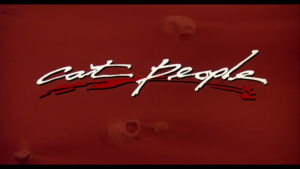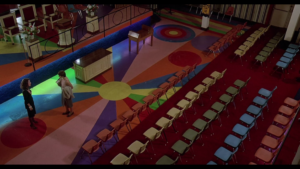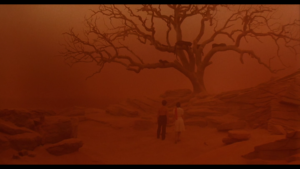Cat People (1982)

This film, written by Alan Ormsby and directed by Paul Schrader, is a loose “remake” of Cat People (1942), which we reviewed a few weeks ago. Hopefully future “Recycled” posts (reviews of a movie and its remake) will come closer together.
Let’s start with how this movie ends:
Shot of panther’s face. Freezeframe. Commence Bowie. At appropriate point in song, unfreeze the freezeframe. Panther roars. Freezeframe again. Roll credits.
This Crazy Ivan-esque maneuver has only been pulled off by the most daring and desperate of movie pilots. A tip of the hat to director Paul Schrader is already in order.
Ok back to how it starts.

Credits roll over orange sands blowing across half-buried skulls. Among the desert sands of Mars Africa probably? warriors take a young woman and tie her to tree on a hill. That night a black panther approaches and rears up in front of her, but the next morning she is alive. We morph from her face into the whiter, present-day face of another young woman, Irena (Natassia Kinski) mmm. She is arriving in New Orleans from an unknown place, an envoy to our world from a better, braless one. Her creepy brother (Malcolm McDowell) stalks her through the airport and only introduces himself when she is about to make a call on a pay phone. They’ve never met as adults.
Irena and Paul have a weird relationship even before the police find the half-eaten hooker corpses in his basement. Their parents, who died when they were young, were circus people, and the siblings remember how to juggle while chanting unsettling rhymes. Paul’s also a religious fanatic involved with what looks like the circus church of latter-day clown jesus (see below).

Gah!
More importantly, the pair are the last remnants of an ancient race of cat people, who turn into panthers when they fuck and back into humans when they kill. This has grim consequences for any non-cat people they might spend the night with. Paul knows all this (hence the hooker corpses) but Irena, as a virgin, has a voyage of self-discovery ahead of her. Both actors pull off some nice moments of cat-like movement and behavior in the movie.

Paul gets stuck in a hotel room as a panther after a hooker gets away from his attempted mauling, and people from the zoo come and put him in captivity. These are our other main characters, Oliver (John Heard) and Alice (Annette O’Toole). They’re good at their jobs, but the captive Paul-panther seems constantly pissed off and scary as hell. Firstly, the hooker attack scene is fucking amazing, scary as hell. Secondly this entirely real panther is terrifying; it’s fearfully magical to see a giant cat bounce around a room like a pinball of furious death and furry muscle. Seriously. Did he who made the Lamb make thee, motherfucker?

Such beautiful eyes
Irena and Oliver end up meeting and falling for each other–even though early on she responds to an offer of aspirin with “Nah, I don’t believe in medicine,” <3 which you think a self-respecting zoologist would find a turn-off. He gets her a job in the zoo gift shop, and from there a relatively tepid love triangle starts up between Irena, Oliver, and Alice. Unlike the Alice in the 1942 Cat People, this Alice doesn’t stand for anything much; she’s a competent woman who’s had a presumably average amount of sex, but isn’t unusually liberated except compared to Irena. If the love triangle means anything, it’s just Oliver’s choice between the alluring danger of Irena and the safer Alice (it’s a conflict within a man, not between two women with different approaches to life). Mercifully, we’re spared this conflict becoming the center of the movie.
The movie’s real core is the myth of the cat people, which comes to the forefront in two magnificent lines:
Paul bursts into Irena’s room through the window, approaches her bed, kneels and says:
“Save me. Only you can stop this killing. You have to make love with me, as brother and sister.”

“We can live together as mates, just as our parents did.”
Later, in a vision set among the orange sands of Africa Mars, he says this:
“Long ago our ancestors sacrificed their children to the leopards. The souls of the children grew inside the leopards until the leopards became human. We were gods then. We are an incestuous race. We can only mate with our own.”

Everything else is icing on this, the meat and potatoes of this superb cat cake. Meat + Potatoes + Icing = Cake.
The myth and certain aspects of the movie’s feel remind me of American Gods. Like: the gods (cat people) were created by people’s worship of them, and now live a weird posthumous existence in America, divorced from the civilization that made them. It’s enough to make me wonder if Neil Gaiman watched this movie.
We won’t go into interpretations the way we did for Cat People (1942), because this movie is in a different mode: less about metaphor, more about beautiful fucked up myth. (Roger Ebert wrote about it: “This is the stuff of audacious myth, combining the perverse, the glorious, and the ridiculous. The movies were invented to tell such stories.” This was one of the first things I read that made me realize Ebert knew what was up and numbered among the sages.) yeah, this movie was the first thing I ever agreed with Ebert on except Nicolas Cage, and I have since come to admire his views on many films.
I will say that the idea of ‘myth’ for me applies to 40’s Cat People more than this one. One is witches and curses, and the other is ‘you’re a magic cat species!’ I’m talking about myth-making–this movie creates/contains a myth that speaks to fucked up little corners of our brains, rather than presenting things that stand for other things.
But we will talk about the strange relationship it has with Cat People (1942).
It’s a remake in only the broadest vaguest sense – both are about a woman who turns into a panther. There’s a zoo and some sorta love triangley stuff. When it comes to meaning, tone, characters, plot, it’s an entirely different film. The first film’s basic idea was a springboard for Alan Ormsby and Paul Schrader that led to a completely different narrative and visual world.
But in a few places, they do lift scenes or moments from the original (the most iconic ones, that one might hope to see redone in a “remake”)– the mysterious cat-like woman who greets Irena as “my sister” in another language (only, in this one, it’s Spanish, a language irrelevant to the story), the bus halting in front of Alice with a sound blended with a panther roar, and the pool sequence.

“Remember that scene from that other movie? Let’s do that, but topless.”
Not a single one of these scenes fits in this movie, and in fact none have any effect on surrounding scenes and could all be cut without disrupting the plot at all.
This leads us to propose what we will call the Cat People Principle (CPP): In a loose adaptation or inspired work, any portions brought in wholesale from the original will be the least fitting and (in context) worst parts of the new work.
I could also call this the Wicker Man Principle.
When a filmmaker wants to or has to pick a completely different focus/story than his source material but is required to pay homage to it. Things taken from the source material will feel as transplanted as they are, and things new will feel as alien as they are to lovers of the source material. Right, lovers of the source material are often expecting a close adaptation no matter what, so the new material will always be the bad part from a certain fanboyish perspective.

“This is the best panther autopsy scene I’ve ever seen in a movie.”
The converse is called the Lord of the Rings Principle (LotRP): In a close or “faithful” adaptation, although it’s probably necessary to delete and rearrange things, any portions purely added by the adapters will probably be the least fitting and worst parts of the new work.
LIKE FUCKING GAME OF THRONES. FUCK THOSE GUYS. Yeah it could as easily be the GoTP.
When a filmmaker goes to great lengths to preserve his perceived focus/story of the source material, but whilst dealing with the edits and cuts and woes of adaptation through some hubris decides he is equal and sly enough to insert his own content and that it will flow seamlessly in the waters of another man’s jelly. He is wrong. He is so fucking dead wrong. His meddlings are the sorest of thumbs and stick out tall and throbbing.
In both cases, the logic is actually the same. Someone has a coherent idea worked out or attempting to be worked out, with its own self-unfolding logic. For the close adaptation, this is the original; for the loose adaptation, it’s the new separate idea inspired by the original. Then pockets of someone else’s idea are inserted, and while they might be good in another context, they don’t fit into the scheme of the original (in the close adaptation) or the new work (in the loose adaptation.)
There can be a murky middle between the two (because that’s how dichotomies work), when you can’t decide if something is a loose adaptation or a close one–sometimes creating the feeling of two movies stitched awkwardly together. There’s also another category to muddy the waters (I’d say it’s more of a factor than a category), which is the Factory Movie–aka, some source material (previous movie, book, comics, toys) is combined with purely generic elements, so it’s not a close adaptation, but the new skeleton the meat is being hung on is not a new, original vision, but just a set of conventions.
What makes Cat People the Younger so great is that, except these few blatantly inserted scenes, it goes so balls-out in the direction of a “loose” remake, a new original film that happens to be inspired by a previous one. Take out the few moments copy-pasted from the Val Lewton movie, and you’ve just got Ormsby and Schrader’s wild-ass vision of sex and death and PANTHER TREE.

PANTHER. TREE.
